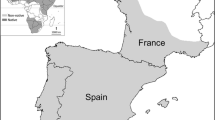Abstract
The secondary sex ratio in sable Martes zibellina L. maintained in captivity was estimated for the first time ever. The data obtained at the Pushkin pedigree breeding farm (Moscow oblast) in 1982 through 1987 were analyzed. In total, 1705 litters of 418 females were examined. The total frequency of male births (P^ was 0.527 ± 0.007; the 95% confidence interval of P^ (the probability of birth of a male) was within the limits 0.513 ≪ p ≪ 0.541, and the deviation from the expected 1 : 1 ratio was statistically significant. No effect of parental age and litter size on the number of male progeny was found. This may indicate a small influence of the parental hormonal and immunological status on sex ratio, which was reported in many other mammal species including those related to sable. Apparently, there is an evolutionary mechanism underlying the stable excess of males in sable litters.
Similar content being viewed by others
REFERENCES
Kaidanov, L.Z., Genetika populyatsii (Population Genetics), Moscow: Vysshaya Shkola, 1996.
Maksimovskii, L.F., Possibilities of a Directional Effect on Formation of the Sex Ratio in Mammalian Progeny, S–kh. Biol., 1988, no. 1, pp. 10-19.
Il'ina, E.D. and Kuznetsov, G.A., Osnovy genetiki i selektsii pushnykh zverei (Basics of Genetics and Breeding of Fur-Bearing Animals), Moscow: Kolos, 1983.
Pavlyuchenko, V.M., Utkin, L.G., Grigor'ev, M.Yu., et al., Kletochnoe razvedenie sobolei (Sable Breeding in Captivity), Moscow: Kolos, 1979.
Beketov, S.V., Secondary Sex Ratio in Mammals, Usp. Sovrem. Biol., 2001, vol. 121, no. 4, pp. 357-377.
Zenov, I.G., Correlation of Sex Ratio in Progeny with Fecundity in Animals, Genetika (Moscow), 1969, vol. 5, no. 2, pp. 92-96.
Maciejowski, J., Genetyczno-populacyjne badania nad rozrodem lisóv polarnych. Cz. 2. Wilkość miotów i liczbowy stosunek płci w potomstwie, Ann. univ. Mariae Curie-Sk?odowska Sektio E (Lublin, Polonia), 1972, vol. 27, no. 23, pp. 359-281.
Łabecka S. Wpływ wieku samic na długość okresu ciazy, liczebność miotu i stosunek płci u lisow polarnych niebieskich (Alopex lagopus L.), Akademia Rolnicza w Szczecinie: Zootechnika, 1985, vol. 21, no. 114, pp. 43-56.
Kuzniewicz, J., Kształtowanie sie liczebnosci szczeniat w miotach i proporcji plci potomstwa lisów polarnych neibieskich w od wieku samic, Zootechnika (Wroclaw), 1986, vol. 29, pp. 169-176.
Grakova, N.V. and Grakov, N.N., Peculiarities of Sex Composition of American Mink Litters in the Embryonic Period and at Birth, Tezisy dokladov k 3 Vsesoyuznoi nauchnoi konferentsii “Biologiya i patologiya pushnykh zverei” (Proc. 3rd All-Union Conf. “Biology and Pathology of Fur-Bearing Animals”), Petrozavodsk, 1981, pp. 128-130.
Shlyapnikova, M.S. and Gileva, E.A., Variation of Sex Ratio in a Laboratory Colony of Large-Toothed Redback Vole and Traivers-Willard Hypothesis, Ekologiya (Sverdlovsk), 1990, no. 5, pp. 73-79.
Joshi, J.S. and Sahni, K.L., A Study on Secondary Sex Ratio in Muzaffarnagari Sheep, Ind. Vet. J., 1980, vol. 60, pp. 996-998.
Fukuhara, R., Inoue, S., and Harada, H., Sex Ratio in Wagyu Cattle (the Japanese Black Cattle), World Conference on Animal Production, Edmonton, 1993, vol. 3, pp. 343-344.
Jamriška M., Analýza pomeru pohlavia v potomstve oši-paných vzhl'adom na vek rodičov a plemennu prisluš-nost' pomer pohlavia, Acta Zootechnica Bratislava, 1991, vol. 47, pp. 119-127.
Beili, N., Statisticheskie metody v biologii (Statistical Methods in Biology), Moscow: Mir, 1964.
Zakharov, I.A. and Goryacheva, I.I., Sex Ratio in Adalia bipunctata Populations and the Population Genetic Significance of a Lack of Males, Genetika (Moscow), 1998, vol. 34, no. 12, pp. 1630-1638.
Clutton-Brock, T.H. and Iason, G.R., Sex Ratio Variation in Mammals, Quat. Rev. Biol., 1986, vol. 61, no. 3, pp. 339-374.
Kubantsev, B.S., On the Sex Composition in Mammals, Zh. Obshch. Biol., 1972, vol. 33, no. 2, pp. 196-204.
Zhegalov, S.B., Regularities of Sex Determination in Animals, Usp. Sovrem. Biol., 1950, vol. 30, no. 1 (4), pp. 131-144.
Author information
Authors and Affiliations
Rights and permissions
About this article
Cite this article
Beketov, S.V., Kashtanov, S.N. Statistical Analysis of Secondary Sex Ratio Variation in Sable Martes zibellina L.. Russian Journal of Genetics 38, 181–187 (2002). https://doi.org/10.1023/A:1014386127980
Issue Date:
DOI: https://doi.org/10.1023/A:1014386127980




